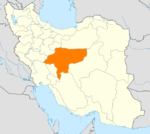- Mashhad-e Ardehal
-
Mashhad-e Ardehal
مشهد اردهال— village — Country  Iran
IranProvince Isfahan Province County Time zone IRST (UTC+3:30) - Summer (DST) IRDT (UTC+4:30) Mashhad-e Ardehal (Persian: مشهد اردهال) is a village in Isfahan Province, Iran. It is located 40-45km east of the city of Kashan. The village contains the burial site of Sultan Ali (the son of the fifth Imam Muhammad al-Baqir) and the notable modern Persian poet and painter Sohrab Sepehri and is known for its annual Carpet Washing Ceremony.[1][2] The tomb of Sohrab Sepehri is located in the eastern wing of the Shrine of Sultan Ali, which lies on the slope of a high hill. The shrine has two magnificent courtyards, a couple of splendid balconies and tall minarets decorated with ceramic tiles. The whole building complex belongs to the Seljuk period architecture.[3]
Contents
Carpet Washing Ceremony
The Carpet Washing (Ghali Shuyan) Ceremony, one of the most interesting religious ceremonies of the Shiites, is held in Mashhad-e Ardehal. It is a traditional/religious/historical mourning ceremony.[4]
The origin of the ceremony can be traced back to the time when Sultan Ali (who was invited from Medina to Mashhad-e Ardehal more than 12 centuries ago) was killed in the village by his enemies. After his followers from the area arrived too late to help him they wrapped his body in a carpet. They then washed his body in a stream 150 meters away, before burying him. So for hundreds of years people in their thousands from the surrounding area and beyond (including Qum, Kashan, Nashlaj, Khomein, Mahallat, Saveh, Delijan, Golpayegan, Yazd, and many other towns) have flocked to Mashhad-e Ardehal to mourn and represent this event each year on the second Friday of the Iranian month of Mehr (early October), since this was the day Sultan Ali was killed. Some pilgrims even walk to the shrine from places that are large distances away. The crowd of pilgrims then leave the shrine carrying the remains of the same sacred carpet (that was used to wrap the body of Sultan Ali) on their shoulders, and while mourning, symbolically beat the remains of the carpet with long sticks to show their hatred towards the enemies of Sultan Ali and to demand revenge for his martyrdom, and also as a means to clean the carpet. Throughout the ceremony no outsider is allowed to touch the remains of the carpet. The pilgrims wear black clothes, sing religious songs, cry and beat their chests (as a sign of grief and mourning) and rotate their sticks in the air and rotate the carpet around the yard of the shrine. They then wash the carpet in a special stream of water near the shrine. The people believe the water then becomes holy, with many pilgrims applying the stream water upon their bodies and also bottling the water to take home with them. The pilgrims then return the carpet back to the shrine and the mourning ends at noon with a giant feast, where thousands are fed for free, before finally returning to their homes.[5][6][7][8]
In 2009, there were 200,000 pilgrims gathered in Mashhad-e Ardehal for the Carpet Washing Ceremony.[9]
See also
References
- ^ The Water's Footfall: Selected Poems. 2004. p. 9. http://books.google.com/books?id=NPxZgcpNdOQC.
- ^ Iran. Lonely Planet. 2004. p. 209. http://books.google.com/books?id=NPxZgcpNdOQC.
- ^ Kashan, in the province of Esfahan: Religious Ceremonies, salamiran.org, written by Administrator, dated Wednesday, 27 September 2006
- ^ Kashan, in the province of Esfahan: Religious Ceremonies, salamiran.org, written by Administrator, dated Wednesday, 27 September 2006
- ^ Payvand Iran News ... Photos: Mashhad Ardehal Rug Washing Ceremony, Photos by Sajjad Safari, Mehr News Agency, dated 10/04/09
- ^ Documentary: “Taste of Iran: Episode 2”, presented by BBC journalist and native Iranian Sadeq Saba, scene shown from 32-35 minutes.
- ^ Kashan, in the province of Esfahan: Religious Ceremonies, salamiran.org, written by Administrator, dated Wednesday, 27 September 2006
- ^ Light Green: Mashhad of Ardehal, 7th of 7 images
- ^ Documentary: “Taste of Iran: Episode 2”, presented by BBC journalist and native Iranian Sadeq Saba, scene shown from 32-35 minutes.
External links
- Imamzadeh Sultan Ali shrine in Mashhad-e Ardehal
- Photo Gallery: Carpet Washing Ceremony in Mashhad-e Ardehal
 Isfahan Province
Isfahan ProvinceCapital Isfahan
Counties (A-L)
and CitiesAran va Bidgol CountyBorkhar CountyDowlatabad • Dastgerd • Habibabad • Khvorzuq • Komeshcheh • ShahpurabadChadegan • RozvehFalavarjan • Abrisham • Baharan Shahr • Imanshahr • Kelishad va Sudarjan • Pir Bakran • Qahderijan • ZazeranFaridan CountyFereydunshahr • Barf AnbarGolpayegan • Golshahr • GugedIsfahan • Baharestan • Ezhiyeh • Harand • Hasanabad • Khvorasgan • Kuhpayeh • Mohammadabad • Nasrabad • Nikabad • Sejzi • Tudeshg • VarzanehKhomeyni Shahr CountyKhomeyni Shahr • Dorcheh Piaz • KushkKhur and Biabanak CountyKhur • JandaqKhvansar CountyKhvansarZarrin Shahr • Bagh-e Bahadoran • Chamgardan • Charmahin • Fuladshahr • Sedeh Lenjan • Varnamkhast • Zayandeh RudCounties (M-Z)
and CitiesSemirom • Hana • Komeh • VanakShahin Shahr and Meymeh CountyShahin Shahr • Gaz • Meymeh • VazvanTiran and Karun CountyTiran • Asgaran • RezvanshahrLandmarks
and
SightsSemirom waterfall • Abyaneh • Niasar fire temple • Atashgah • Babapir • Gogad citadel • Yazdgerd's palace • Grand Bazaar, Esfahan • Kashan Bazaar • Fin Garden • Khaju Bridge • Tappeh Sialk • Si-o-se Pol • Ali Qapu • Shahghandab cave • Mashhad_Ardehal ceremony • Maranjab caravansary • Hasht Behesht • Vank Cathedral • Chahar Bagh School • Qamsar rose water ceremony • Jameh Mosque of Ashtarjan • Jameh Mosque of Isfahan • Shah Mosque • Sheikh Lotf Allah Mosque • Manar Jonban • Naqsh-e Jahan Square • Narin ghaleh • Sultan Amir Ahmad Bathhouse • Agha Bozorg Mosque • Boroujerdi ha Residence • Tabatabaie Residence • House of the Āmeri family • Abbasian House • Chahar Bagh • New JulfaCategories:- Isfahan Province geography stubs
- Populated places in Isfahan Province
Wikimedia Foundation. 2010.
